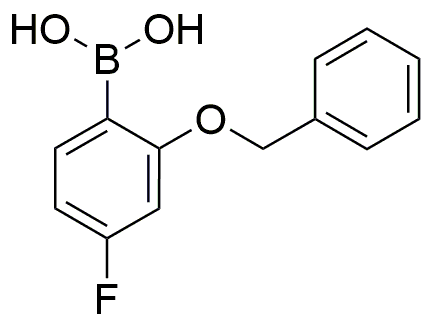2-Benzyloxy-4-fluorophenylboronic acid is widely utilized in research focused on:
- Pharmaceutical Development: This compound serves as a key intermediate in the synthesis of various pharmaceuticals, particularly in developing drugs targeting cancer and other diseases due to its ability to form stable complexes with biomolecules.
- Organic Synthesis: It is employed in cross-coupling reactions, such as Suzuki-Miyaura coupling, allowing chemists to create complex organic molecules efficiently, which is essential in materials science and drug discovery.
- Bioconjugation: The boronic acid functionality enables selective binding to diols, making it valuable in bioconjugation techniques for labeling biomolecules, enhancing imaging and therapeutic applications in biotechnology.
- Sensor Development: This compound can be used in the development of chemical sensors, particularly for detecting glucose levels, offering potential benefits in diabetes management through its selective binding properties.
- Material Science: Its unique properties allow it to be incorporated into polymeric materials, improving their mechanical and thermal stability, which is beneficial in producing high-performance materials for various industrial applications.
General Information
Properties
Safety and Regulations
Applications
2-Benzyloxy-4-fluorophenylboronic acid is widely utilized in research focused on:
- Pharmaceutical Development: This compound serves as a key intermediate in the synthesis of various pharmaceuticals, particularly in developing drugs targeting cancer and other diseases due to its ability to form stable complexes with biomolecules.
- Organic Synthesis: It is employed in cross-coupling reactions, such as Suzuki-Miyaura coupling, allowing chemists to create complex organic molecules efficiently, which is essential in materials science and drug discovery.
- Bioconjugation: The boronic acid functionality enables selective binding to diols, making it valuable in bioconjugation techniques for labeling biomolecules, enhancing imaging and therapeutic applications in biotechnology.
- Sensor Development: This compound can be used in the development of chemical sensors, particularly for detecting glucose levels, offering potential benefits in diabetes management through its selective binding properties.
- Material Science: Its unique properties allow it to be incorporated into polymeric materials, improving their mechanical and thermal stability, which is beneficial in producing high-performance materials for various industrial applications.
Documents
Safety Data Sheets (SDS)
The SDS provides comprehensive safety information on handling, storage, and disposal of the product.
Product Specification (PS)
The PS provides a comprehensive breakdown of the product’s properties, including chemical composition, physical state, purity, and storage requirements. It also details acceptable quality ranges and the product's intended applications.
Certificates of Analysis (COA)
Search for Certificates of Analysis (COA) by entering the products Lot Number. Lot and Batch Numbers can be found on a product’s label following the words ‘Lot’ or ‘Batch’.
*Catalog Number
*Lot Number
Certificates Of Origin (COO)
This COO confirms the country where the product was manufactured, and also details the materials and components used in it and whether it is derived from natural, synthetic, or other specific sources. This certificate may be required for customs, trade, and regulatory compliance.
*Catalog Number
*Lot Number
Safety Data Sheets (SDS)
The SDS provides comprehensive safety information on handling, storage, and disposal of the product.
DownloadProduct Specification (PS)
The PS provides a comprehensive breakdown of the product’s properties, including chemical composition, physical state, purity, and storage requirements. It also details acceptable quality ranges and the product's intended applications.
DownloadCertificates of Analysis (COA)
Search for Certificates of Analysis (COA) by entering the products Lot Number. Lot and Batch Numbers can be found on a product’s label following the words ‘Lot’ or ‘Batch’.
*Catalog Number
*Lot Number
Certificates Of Origin (COO)
This COO confirms the country where the product was manufactured, and also details the materials and components used in it and whether it is derived from natural, synthetic, or other specific sources. This certificate may be required for customs, trade, and regulatory compliance.


